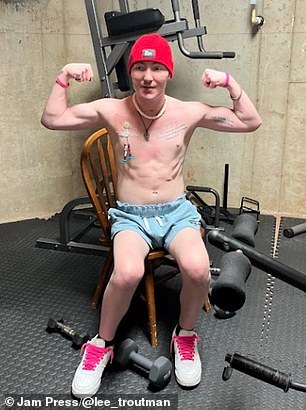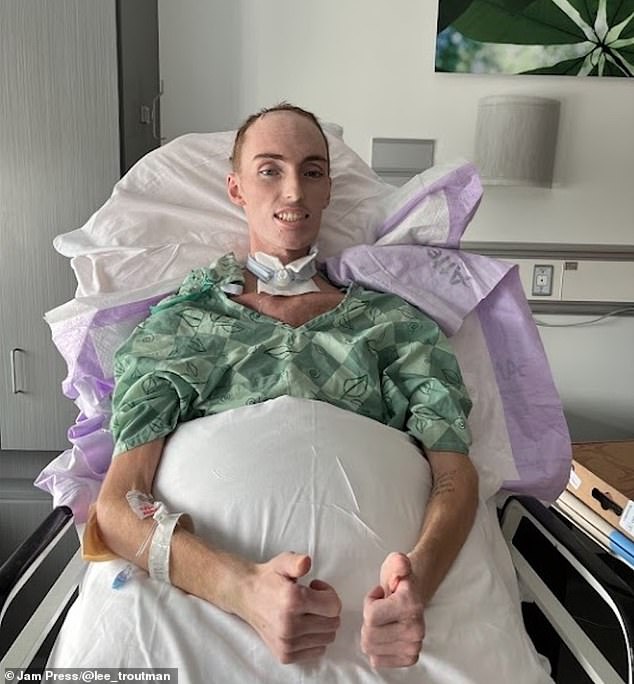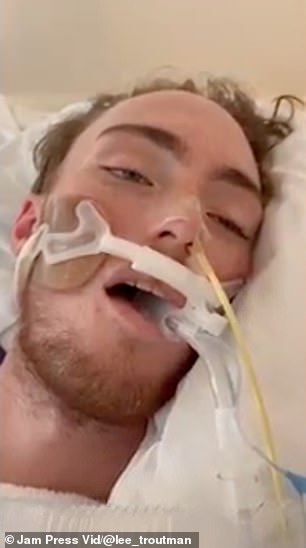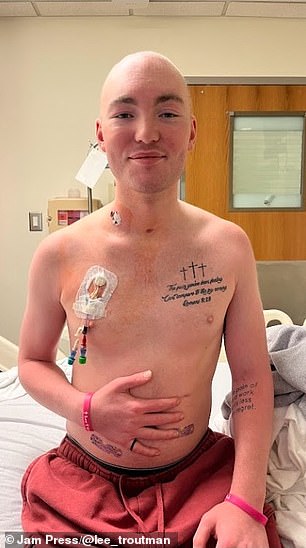I was diagnosed with terminal non-Hodgkin’s lymphoma cancer aged 20 despite being in peak physical condition – I mistook my symptoms as burnout
A fitness influencer who was diagnosed with a rare but deadly cancer thought his symptoms stemmed from “working too much.”
Lee Troutman, of Atlanta, Georgia, was diagnosed with late-stage non-Hodgkin’s lymphoma last year after experiencing night sweats, fatigue, and liver pain.
Leading up to his diagnosis, Mr. Troutman, then 20, trained 12 hours a day and trained clients to become fitness instructors.
By the time the doctors discovered the cancer, he could no longer walk, talk or eat. He had also lost half his body weight in just two months.
“The doctors didn’t think I would survive,” Mr. Troutman said.
Mr. Troutman is among the growing number of young people who have been diagnosed with cancer in recent decades – a trend doctors still don’t fully understand.

Lee Troutman, of Atlanta, Georgia, was diagnosed with late-stage non-Hodgkin’s lymphoma last year after experiencing night sweats, fatigue, and liver pain. Just before the diagnosis, he trained twelve hours a day. By the time the doctors discovered his cancer, he could no longer walk, talk or eat

Mr. Troutman’s case was serious. The cancer had spread to all four lobes of the brain: the brainstem, spine, liver, ribs, and hips
When he first went to the doctor in October 2021, he was diagnosed with mononucleosis, or “mono,” caused by the Epstein-Barr virus (EBV).
Then, after multiple rounds of testing, doctors discovered hemophagocytic lymphohistiocytosis (HLH), an immune system response that can cause organs to shut down, as well as non-Hodgkin’s lymphoma (NHL).
NHL is a type of lymphoma, a cancer of the lymph nodes, the body’s disease-fighting network, which includes the spleen, bone marrow, lymph nodes, and thymus.
It can occur anywhere in the body, but usually the first sign is swollen lymph nodes around the neck.
Other symptoms include abdominal pain or swelling, chest pain, cough, difficulty breathing, persistent fatigue, fever, night sweats and unexplained weight loss, according to the Mayo Clinic.
NHL affects about 80,000 people each year in the US and 14,000 in the UK. It kills about 20,000 people in the US and nearly 5,000 in Britain.
The National Cancer Institute (NCI) estimates that nearly three-quarters of NHL patients survive beyond five years. Even after the cancer has spread, more than half remain alive.
However, Mr. Troutman’s case was serious. The cancer had spread to all four lobes of the brain: the brainstem, spine, liver, ribs, and hips.


In May 2022, Mr. Troutman finally received a bone marrow transplant from an anonymous donor. He then spent 200 days in quarantine, taking 63 drugs every day to ensure the transplant was not rejected. “The quarantine tested my sanity,” he said. ‘It was difficult not being able to see people for 200 days’
“My mother and I found a doctor who agreed to take my case. He gave me hope with a five percent survival rate,” he said.
“He said if I wanted to survive the lymphoma and the aggressive cancer treatments I would need a bone marrow transplant.”
“And after that I’d have a seventy percent chance of getting through.”
Mr. Troutman was about to undergo a bone marrow transplant when his lungs collapsed twice. He was put on a ventilator and placed on a feeding tube.
After being taken off the ventilator, Mr. Troutman spent months in rehab trying to regain weight and muscle mass, while still undergoing chemotherapy, to be strong enough for the surgery.
“During this time, I re-learned how to do pretty much everything from walking to eating,” he said.
He estimates that he has had at least 50 platelet and blood transfusions and more chemotherapies than he can count.
“At the time I couldn’t remember the treatments, but when I look back on it, it’s overwhelming,” he said.
In May 2022, Mr. Troutman finally received a bone marrow transplant from an anonymous donor. He then spent 200 days in quarantine, taking 63 drugs every day to ensure the transplant was not rejected.
“The quarantine tested my sanity,” he said. “It was hard not seeing people for 200 days.”
“I was lonely and I actually missed the hospital where I regularly saw doctors, nurses and therapists.”
Mr. Troutman is now in remission and is undergoing regular testing and follow-up appointments to make sure the cancer does not return.
“The hospital saved my life, but I hope I never have to go back,” he said.
Now Mr. Troutman is eager to get back to doing what he loves most: fitness and the gym.
“I’m finally looking forward to my future,” he said.
“If anyone is going through something similar, stay strong, keep fighting and don’t give up.”
“If the doctors have given up, find a new doctor.”
“Be your own advocate.”
